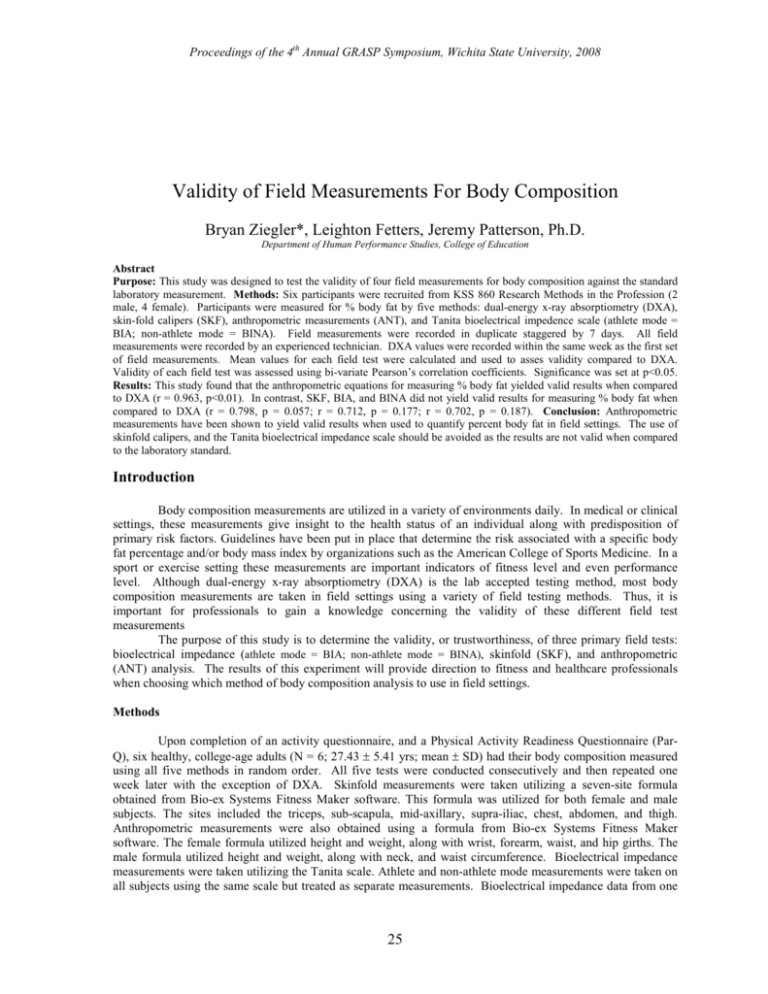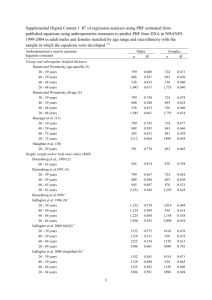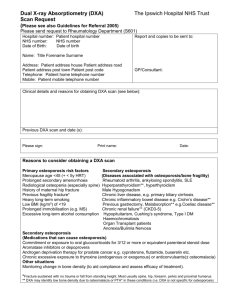Validity of Field Measurements For Body Composition
advertisement

Proceedings of the 4th Annual GRASP Symposium, Wichita State University, 2008 Validity of Field Measurements For Body Composition Bryan Ziegler*, Leighton Fetters, Jeremy Patterson, Ph.D. Department of Human Performance Studies, College of Education Abstract Purpose: This study was designed to test the validity of four field measurements for body composition against the standard laboratory measurement. Methods: Six participants were recruited from KSS 860 Research Methods in the Profession (2 male, 4 female). Participants were measured for % body fat by five methods: dual-energy x-ray absorptiometry (DXA), skin-fold calipers (SKF), anthropometric measurements (ANT), and Tanita bioelectrical impedence scale (athlete mode = BIA; non-athlete mode = BINA). Field measurements were recorded in duplicate staggered by 7 days. All field measurements were recorded by an experienced technician. DXA values were recorded within the same week as the first set of field measurements. Mean values for each field test were calculated and used to asses validity compared to DXA. Validity of each field test was assessed using bi-variate Pearson’s correlation coefficients. Significance was set at p<0.05. Results: This study found that the anthropometric equations for measuring % body fat yielded valid results when compared to DXA (r = 0.963, p<0.01). In contrast, SKF, BIA, and BINA did not yield valid results for measuring % body fat when compared to DXA (r = 0.798, p = 0.057; r = 0.712, p = 0.177; r = 0.702, p = 0.187). Conclusion: Anthropometric measurements have been shown to yield valid results when used to quantify percent body fat in field settings. The use of skinfold calipers, and the Tanita bioelectrical impedance scale should be avoided as the results are not valid when compared to the laboratory standard. Introduction Body composition measurements are utilized in a variety of environments daily. In medical or clinical settings, these measurements give insight to the health status of an individual along with predisposition of primary risk factors. Guidelines have been put in place that determine the risk associated with a specific body fat percentage and/or body mass index by organizations such as the American College of Sports Medicine. In a sport or exercise setting these measurements are important indicators of fitness level and even performance level. Although dual-energy x-ray absorptiometry (DXA) is the lab accepted testing method, most body composition measurements are taken in field settings using a variety of field testing methods. Thus, it is important for professionals to gain a knowledge concerning the validity of these different field test measurements The purpose of this study is to determine the validity, or trustworthiness, of three primary field tests: bioelectrical impedance (athlete mode = BIA; non-athlete mode = BINA), skinfold (SKF), and anthropometric (ANT) analysis. The results of this experiment will provide direction to fitness and healthcare professionals when choosing which method of body composition analysis to use in field settings. Methods Upon completion of an activity questionnaire, and a Physical Activity Readiness Questionnaire (ParQ), six healthy, college-age adults (N = 6; 27.43 ± 5.41 yrs; mean ± SD) had their body composition measured using all five methods in random order. All five tests were conducted consecutively and then repeated one week later with the exception of DXA. Skinfold measurements were taken utilizing a seven-site formula obtained from Bio-ex Systems Fitness Maker software. This formula was utilized for both female and male subjects. The sites included the triceps, sub-scapula, mid-axillary, supra-iliac, chest, abdomen, and thigh. Anthropometric measurements were also obtained using a formula from Bio-ex Systems Fitness Maker software. The female formula utilized height and weight, along with wrist, forearm, waist, and hip girths. The male formula utilized height and weight, along with neck, and waist circumference. Bioelectrical impedance measurements were taken utilizing the Tanita scale. Athlete and non-athlete mode measurements were taken on all subjects using the same scale but treated as separate measurements. Bioelectrical impedance data from one 25 Proceedings of the 4th Annual GRASP Symposium, Wichita State University, 2008 participant was removed from the study because only one measurement was made due to an injury that was unrelated to the study. Thus for BIA and BINA, sample size was five (N = 5). Statistical analysis of results was performed using SPSS for Windows (ver. 15.0). Mean values for each field test measurement were calculated and subsequently used to determine validity. Validity for each field test measurement compared to DXA was analyzed using bi-variate Pearson’s correlation coefficients. Significance was set at p<0.05. All methods were approved by the university’s Institutional Review Board (IRB). Results Statistical analysis of ANT found a significantly high correlation when compared to DXA (r = 0.963, p<0.01). This high correlation allows for anthropometric measurements following Bio-ex Systems Fitness Maker software to be used in the field setting as a valid measurement for percent body fat. In contrast, no other field measurement was found to have a significant correlation when compared to DXA. Pearson’s correlation coefficients for SKF, BIA, and BINA compared to DXA were r = 0.798, r = 0.712, and r = 0.702, respectively. Table: 1 Percent Body Fat Mean Measurements (* denotes singular measurement) BIA Subject 1 16.8 Subject 2 18.6 Subject 3 11.4 Subject 4 14.5 Subject 5 -Subject 6 21.2 BINA 22.3 19.5 18.2 22.7 -23.1 SKF 22.6 21.3 13.9 22.8 24.1 23.2 ANT 35.6 29.1 15.1 19.3 36.1 31.5 DXA* 28.3 23.4 19.4 22.3 28.4 26.2 Discussion Many different bioelectrical impedance analyzers are available to the industry at the current time. Additionally, there are numerous different equations that make use of anthropometric measurements to estimate percent body fat. The validity of several Omicron hand to hand bioelectrical impedance analyzers and other anthropometric equations of estimating body composition compared to DXA have been previously validated [1]. However, to the author’s knowledge, the validity of the Tanita bioelectrical impedance scale (a foot to foot device) and the specific anthropometric equations used in this study compared to DXA have not been established. This study establishes the validity of the anthropometric equations used in Bio-ex Systems Fitness Maker software. As a result, the fitness and healthcare professionals can use this method in the field with a high level of certainty. However, a limitation of this study was its small sample size. A larger sample with an equal distribution of males and females is warranted to increase the power of this validity study. Conclusions When choosing a specific protocol to use in field settings in order to quantify percent body fat, fitness professionals should be aware that not all common methods are valid when compared to the lab standard, DXA. This experiment shows that of the four common field tests analyzed for validity, only the anthropometric equations from Bio-ex Systems Fitness Maker software yielded values that are valid when compared to DXA. Thus, skinfold measurements from Bio-ex Systems Fitness Maker software and Tanita bioelectrical impedance scales should be avoided as tools to quantify percent body fat. Acknowledgements The authors wish to thank Kaelin Young for his assistance in statistical analysis. Additionally, acknowledgement is to be made to the students of KSS 860 for willingly participating in this study. [1] Gibson, A., Heyward, V., & Mermier, C. (2000). Predictive accuracy of Omron body logic analyzer in estimating relative body fat of adults. International journal of sport nutrition and exercise metabolism, 10(2), 11. 26






